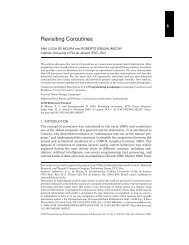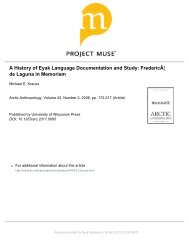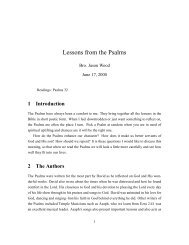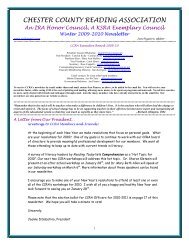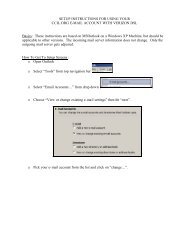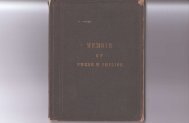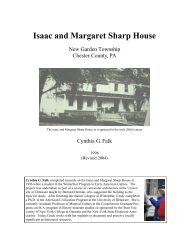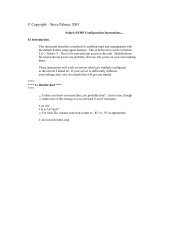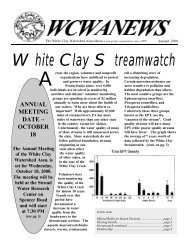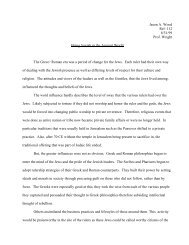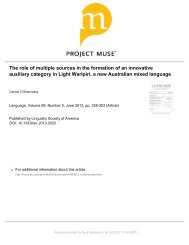Create successful ePaper yourself
Turn your PDF publications into a flip-book with our unique Google optimized e-Paper software.
Roman-Based Alphabetic Systems<br />
(pre-19th Century)<br />
The reform of traditional orthographies (notably<br />
those of French and English, which presented particular<br />
problems for learners) led to innovations<br />
in notation. In France, Loys Meigret’s La Tretté de<br />
la grammere françoeze (1550; see Meigret, Louis<br />
(?1500-1558)) included a phonetically based alphabet<br />
for French. In England, Sir Thomas Smith, in his<br />
De recta et emendata linguae anglicanae scriptura<br />
(On the proper and corrected writing of the English<br />
language) (Paris, 1568), employed several of the<br />
devices mentioned previously. For example, diacritics<br />
([ H]) were used to distinguish the long vowels in<br />
‘cheap’ and ‘hate,’ symbolized and , respectively;<br />
non-Roman alphabets (Greek ) were used<br />
for French and Scottish u (i.e., [y]); and the Irish form<br />
of capital was used to represent the first consonant<br />
in ‘judge.’ A reversed replaced the of<br />
‘ship,’ and for the dental fricatives, Smith used Old<br />
English ‘thorn’ and (see Figure 1).<br />
John Hart (see Hart, John (?1501-1574)) was familiar<br />
with Meigret’s system. His book, An orthographie<br />
(London, 1569), included special symbols for the<br />
consonant sounds [y ð S tS dZ], beautifully integrated<br />
into the text. He was a keen observer of speech and<br />
recorded the occurrence of syllabic consonants such<br />
as the final in ‘fable,’ which he transcribed as<br />
. Subsequently, William Bullokar (see Bullokar,<br />
William (c. 1531–1609)), in his Book at large for the<br />
amendment of orthographie for English speech (London,<br />
1580), provided 40 symbols for transcribing<br />
English. By using a font he opened up<br />
extra possibilities of rarely used printing sorts. He<br />
illustrated his phonetic alphabet by using it in a number<br />
of literary texts, including Aesop’s fables.<br />
In Logonomia Anglica (first edition published<br />
in London in 1619), Alexander Gill (1564–1635)<br />
introduced a number of extra letters. Like Smith, he<br />
used for the first sound in ‘this,’ and in the<br />
second edition (1621) of his work he introduced<br />
for the velar nasal, thus maintaining the connection<br />
with nasal . He transcribed the word ‘high’<br />
as , using for the vowel and for the<br />
final consonant. This illustrates the use of a diacritic<br />
incorporated in a letter. Charles Butler, in his English<br />
Figure 1 Symbols devised in 1568 by Sir Thomas Smith, to<br />
represent the final sound made when pronouncing the words<br />
pith, bathe, and dish.<br />
<strong>Phonetic</strong> <strong>Transcription</strong>: <strong>History</strong> 399<br />
grammar (Oxford, 1633), also used a horizontal<br />
stroke through certain letters to avoid digraphs,<br />
replacing the letter , so that instead of he had , respectively, with<br />
a stroke through each letter. He also introduced<br />
inverted to represent the in ‘thin.’<br />
John Wilkins (see Wilkins, John (1614–1672)), in<br />
his Essay towards a real character (1668), devised<br />
three separate systems of notation (see Figure 2).<br />
One of these is Roman based and uses digraphs to<br />
supply extra consonant symbols. The letter has<br />
a dual role: it is used both to indicate fricatives, as in<br />
(for [x X y ð S Z]), and to<br />
indicate voiceless forms of nasals and liquids, so that<br />
voiced are paralleled by [voiceless<br />
. For some of the vowels,<br />
Wilkins employed rather poorly designed Greek symbols,<br />
though this contradicted one of his stated principles<br />
for choosing symbols:<br />
1. They should be the most simple and facil, and yet<br />
elegant and comely as to the shape of them.<br />
2. They must be sufficiently distinguished from one<br />
another.<br />
3. There should be some kind of suitableness, or correspondency<br />
of the figure to the nature and kind of the<br />
letters which they express.<br />
Wilkins’s third condition refers to a nonarbitrary, or<br />
iconic, type of notation (for his other notations, see<br />
later, Iconic Alphabets, pre-19th Century).<br />
Figure 2 Three non-Roman transcriptions. (A) Iconic representations<br />
of the sounds [l] and [m] (John Wilkins, 1668). (B) Syllabic<br />
transcription of ‘Give us this day our daily bread’ (John Wilkins,<br />
1868). (C) Organic alphabet. <strong>Transcription</strong> of ‘I remember. I<br />
remember, the roses red and white’ (Henry Sweet, 1906).



